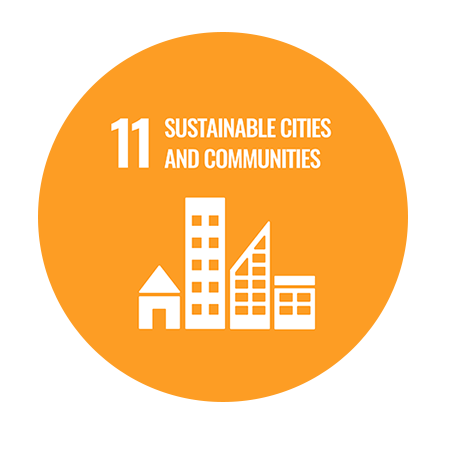The United Nation's 2030 Agenda for Sustainable Development is a shared blueprint of how we create a world where all people can enjoy peace and prosperity. The blueprint is underpinned by 17 Sustainable Development Goals that call for a global partnership to overcome our biggest challenges.
Researchers at the Institute for Molecular Bioscience are contributing towards the UN Sustainable Development Goals in a number of ways, working to improve the lives of those in our local and global communities. We are particularly focused on:
 SDG #3 - Good health and wellbeing
SDG #3 - Good health and wellbeing
Ensure healthy lives and promote well-being for all at all ages.
IMB researchers are developing better ways to predict, prevent and treat some of the leading causes of death in the world, such as heart disease and stroke, and diseases that disproportionately affect developing and middle-income countries, such as antimicrobial resistance, and First Nations populations, such as rheumatic heart disease.
From diseases that affect us at the very start of life, such as birth defects, to diseases that plague our final years, such as dementia, our scientists are searching for solutions. We have clusters of expertise in chronic diseases, infectious diseases, genetics and genomics, and drug development, allowing for intra- and interdisciplinary approaches that see problems from new angles. We are tackling:
- Heart disease
- Stroke
- Chronic pain
- Endometriosis
- Cancer
- Neurological disorders
- Mental health
- Inflammatory diseases
- Ageing and neurodegenerative diseases, such as Alzheimer's, Parkinson's and dementia
- Birth defects and rare disorders
- Chronic respiratory diseases
- Diabetes
- Chronic liver disease
- Kidney disease
- Urinary tract infections (UTIs)
- Group A Streptococci (Strep A)
- Malaria
- Neonatal meningitis
- Sepsis
 SDG #10 - Reduced inequalities
SDG #10 - Reduced inequalities
Reduce inequalities within and among countries
Addressing the health inequity that exists in minority populations in Australia, and among some of our vulnerable neighbours in the Indo-Pacific region, is a major area of focus for our researchers. We are building networks and collaborations across the globe to tackle issues that are exacerbated by poverty and lack of access to healthcare, medicines and health education and are working to increase the diversity of samples available from under-represented populations to build more accurate prediction, prevention and treatment strategies for minority populations.
We strive to make treatments more affordable, and accessible to regional and remote communities across the globe. This work includes developing medicines that can be grown in plants, which would be more affordable, effective and easily distributed; and a treatment for stroke that could be administered by first responders, rather than needing patients to be transported to a hospital with high-level imaging equipment.
A small selection of current research projects includes:
Rheumatic heart disease
Rheumatic fever, caused by Group A Streptococcus, primarily affects children and adolescents in low- and middle-income countries, especially where poverty is widespread and access to health services is limited. Despite it being eradicated in many parts of the world, the disease remains prevalent in sub-Saharan Africa, the Middle East, Central and South Asia, the South Pacific, and among immigrants and older adults in high-income countries, especially in indigenous peoples. Professor Mark Walker is developing an mRNA vaccine against Strep A bacteria, which causes diseases including rheumatic heart fever, the infection that damages the heart and leads to rheumatic heart disease.
Malaria
The latest malaria figures from the World Health Organization reported 247 million cases in 2021, with an estimated 619 000 malaria-related deaths. Nearly half of the world’s population remains at risk of malaria, and over the last decade, antimalarial drug resistance has emerged as a threat to global control efforts. Professor Denise Doolan leads the development of vaccines, diagnostics and host-directed therapeutics for infectious and chronic diseases that impact global public health, with a particular focus on malaria.
Superbugs
Superbugs are becoming increasingly resistant to antibiotics. In 2019, nearly 5 million deaths worldwide were associated with drug-resistant bacterial infections, with the highest mortality rate found in sub-Saharan Africa. By 2050, it’s predicted that resistant infections will directly cause 10 million deaths per year. More than half of all antibiotics have been developed from microbes found in nature. Professor Ian Henderson is working with researchers from across the globe to develop vaccines for anti-microbial resistant infections.
Growing medicines in plants
Royal Society Fellow Professor David Craik is turning plants into ‘medicine factories’. His vision is to improve access to life-saving medicines for everyone, including those in countries with limited cold-chain distribution networks and where donated pharmaceutical stocks often end up on the black market. In addition to improving accessibility, growing medicine in plants has been proven to be more cost-effective and sustainable than traditional drug manufacturing methods, reducing waste dramatically. This method can also scale up very sustainably, using just light, water and nutrients.
 SDG #11 - Sustainable Cities and Communities
SDG #11 - Sustainable Cities and Communities
Make cities and human settlements inclusive, safe, resilient and sustainable
Projections show the world's crop production will need to double by 2050 to support our increasing global population. Achieving this in a sustainable way requires insecticides that don't contain harmful chemicals. An IMB researcher brought the world's first peptide-based insecticide to market, and we continue to work with industry to develop bee-friendly insecticides from molecules isolated from Australian plants and animals.
IMB researchers are also harnessing the ability of algae to use solar energy to make products such as biofuel, food and medicine. Integrating microalgae systems into buildings and roads could provide thermal control, power, abate street noise and manufacture bio-products while absorbing carbon dioxide and pollutants from the air - all while being visually striking.
